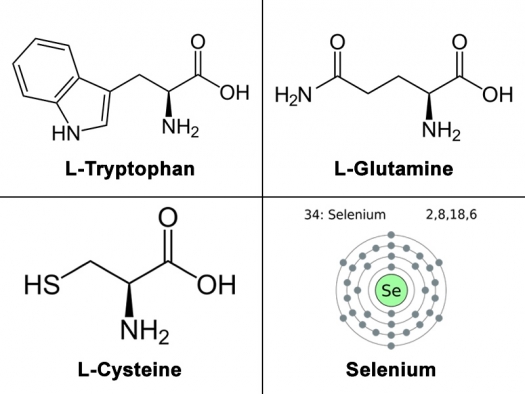L-Tryptophan-L-Glutamine-L-Cysteine-Selenium.jpg

All images from Wikimedia Commons. L-Tryptophan, L-Glutamine, L-Cysteine are public domain. Selenium is CC BY-SA 2.0 UK by Greg Robson.
Have you ever heard of cyto-megalo virus? Unless you are a medical professional, probably not. However, there is a good chance that you have this virus. It just doesn’t do much to someone who keeps their immune system functioning well. HIV is another virus that falls in the same category. As long as you keep your immune system up and running, HIV does not need to be anything more than an annoyance.
What I am going to describe here is a simple therapy that uses only commonly available, inexpensive, non-prescription nutrients that can turn AIDS back into a low-level HIV infection. It is also reasonable to expect that, in time, the patient will require no AIDS drugs and show no AIDS symptoms.
My major source document is an online book that you can read on the internet. The name of the book is What Really Causes AIDS by Harold Foster Ph.D.
As an infectious agent, the HIV virus is sort of a dud. It isn’t very infectious, and once it does infect a person, it doesn’t really do very much damage. Remember that people don’t really die from the HIV infection. Instead they die from opportunistic infections that appear because of the immune-system destroying effect of HIV.
The downward spiral
The HIV virus does have one characteristic that can cause immune system problems. It produces something almost identical to glutathione peroxidase. Glutathione peroxidase is an enzyme that is very prominent in the immune and detoxification systems.
In a healthy person, when they become infected with HIV, very little happens at first. The HIV virus is recognized by the immune system, and kept at very low levels. The raw materials used to make glutathione peroxidase are commonly in good enough supply so that losing a little to the HIV virus has no material effect.
Eventually, there may be a dip in the supply of nutrients used to produce glutathione peroxidase. This has a slight negative effect on the immune system, which, of course allows the HIV virus to proliferate a bit more, which causes yet another drop in the nutrients used to create glutathione peroxidase. And so it goes.
Once this downward spiral begins, it can be self-perpetuating, and result in death from opportunistic infections.
Why drug treatments have serious limitations
Conventional drug treatments for AIDS/HIV have focused on attacking the HIV virus – killing it, preventing it from entering cells, or preventing it from duplicating. This approach has run into several problems. First, it turns your body into a battleground and so the side effects mount up. Second, the virus tends to develop resistance to the drugs, so the drug combinations need to be shifted. But most importantly, this approach never addresses the nutrient deficiency, so if the virus develops resistance to the drugs, or the drugs are no longer available, the virus always has an easy path to proliferate to higher and higher levels.
The nutrient formula for the production of glutathione peroxidase is comprised of L-Cysteine, L-Glutamine, L-Tryptophan, and Selenium. As long as these nutrients are in plentiful supply, the human immune system will not be deprived of anything it needs by the HIV virus, and although a person may be infected with the HIV virus, they will not have AIDS symptoms.
AIDS symptoms are actually symptoms of nutritional deficiencies
One very interesting point is that AIDS symptoms are merely a composite of the deficiency symptoms of these four nutrients.
L-Tryptophan is commonly converted to niacin, and so the niacin deficiency symptoms are of interest here. The most common symptoms of niacin deficiency are muscular weakness, fatigue, loss of appetite, vomiting, and depression. Pellagra is a disease that is a more extreme niacin deficiency. Its four symptoms are dermatitis, dementia, diarrhea, and death.
L-Glutamine deficiency primarily concerns the integrity of the intestinal lining and primarily of the small intestine. Because most L-Glutamine is used to maintain the intestinal walls, absorption of nutrients becomes compromised and undigested food particles and toxins can more easily pass into the bloodstream. L-Glutamine is also used in tissue generation, so a deficiency can easily result in muscle-wasting. L-Glutamine is often used as a post-operative supplement to decrease healing time.
L-Cysteine is essential for the production of both L-Glutathione and T-Cells, so it has the strongest negative effects on the immune system of any of the amino acids when it is in deficiency.
Selenium deficiency is commonly associated with depression, immune system problems, particularly with viral infections, cancer, and heart disease (primarily because coxsackie virus may periodically get out of control).
So these nutritional deficiencies directly explain the following common AIDS symptoms:
- Muscle wasting - Glutamine
- Diarrhea – Glutamine, Tryptophan
- Depression – Selenium
- Heart problems, heart attacks – Selenium, Glutamine
- Karposi’s sarcoma – Selenium
- Psychosis, Dementia – Tryptophan
- Immune weakness – All four
Dosages are important
Of course, there are complications. L-Tryptophan was implicated in a poisoning incident from a manufacturing contaminant in 1989 and has not completely recovered in public perception. L-Glutamine has an effect on the levels of the “excitotoxin” glutamate and so should be used carefully. Selenium, being a mineral, is also subject to overdose problems. So getting the dosages correct really does matter.
How well does it work ?
Also, there is the question of what additional nutrients a sick AIDS patient needs to recover not only from AIDS, but also from the concurrent physical devastation that can accompany the infection. In an article in the Journal of Orthomolecular Medicine (Fourth Quarter, 2006), Dr. Foster describes a formula that he devised for very sick AIDS patients. In addition to the four “main” ingredients, vitamin C, alpha-lipoic acid, and the minerals typically depleted by diarrhea are added.
So the remaining big question is – when this theory is put into practice, how well does it work? In the same article, Dr. Foster describes the results of the first African trials of his AIDS “formula.” Dr. Foster states in his conclusions, that “Firstly, it is possible to reverse all the symptoms of AIDS in dying patients using nutrition alone….There appear to be no adverse side effects from these nutritional treatments.”


